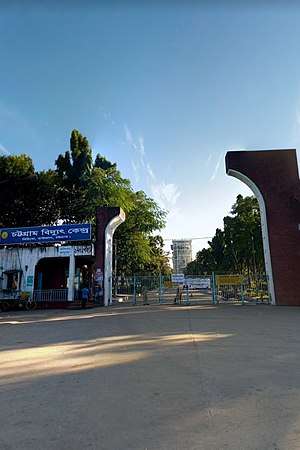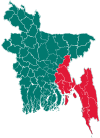Raozan Upazila
Raozan (Bengali: রাউজান) is an Upazila of Chittagong District[1] in the Division of Chittagong, Bangladesh. It was established in 1947.

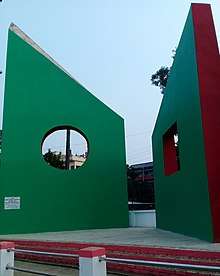
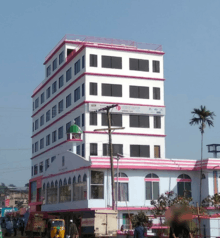

Raozan Upazila রাউজান উপজেলা | |
|---|---|
Upazila | |
 Entrance to the Chittagong University of Engineering and Technology | |
 Raozan Upazila Location in Bangladesh | |
| Coordinates: 22°32′N 91°56′E | |
| Country | |
| Division | Chittagong Division |
| District | Chittagong District |
| Government | |
| • MP | A. B. M. Fazle Karim Chowdhury |
| Area | |
| • Total | 246.58 km2 (95.21 sq mi) |
| Population (2011) | |
| • Total | 325,389 |
| • Density | 1,300/km2 (3,400/sq mi) |
| Time zone | UTC+6 (BST) |
| Post Code | 4340 |
| National Calling Code | +880 |
| Website | raozan |
Geography
Raozan has 45,775 households and a total area of 246.58 km².
The two main rivers are Karnaphuli and Halda.
Raozan is surrounded by Fatikchhari Upazila on the north, Boalkhali Upazila and Karnafuli river on the south, Rangunia and Kawkhali (Rangamati) Upazilas on the east, and Hathazari and Fatikchhari Upazila on the west.
Historical events
From about 1000 years before the conquest of Chittagong in 1666, the entire Chittagong region was under the control of the Buddhist religion, Mog or Arakanese. It is believed that in Arakan, it was called 'Raajwang' or the land of the royal family. The idea of eminent scholars is to say that Raozan has originated from the name of this name.
In August 1947, the activities of Raozan Police Station were started and in 1984 it was turned into an upazila. It was declared as Raozan Municipality in 2000.
War of Liberation
On 13 April 1971, the Pak army carried out extensive loot and firing in Raozan Upazila of Pahartali union Unsotturpara and killed 48 innocent people. On the same day, Saifuddin Khaled Chowdhury, Professor Dilip Kumar Chowdhury, Sheikh Mozaffar Ahmad, Abdur Rab and Yunus were martyred in front of the Chittagong Engineering College (now CUET) in front of the Pak army. The memorial plaques of the martyrs have been uncovered at the place.
On April 13, 1971, the Pak army and the Razakars were brutally killed in front of his organization, Nutan Chandra Singha, founder principal of Kundeshwari Pharmacy. In addition, 35 Pakistani soldiers were killed arbitrarily by the Jagatmallapara of Ward No. 4 in Raozan Municipality.
- Memorandum
Mass killing site: 3 (Unsotturpara, Jagatmallapara, Gohira-Shilapara)
- Memorial monument: 1 (name of martyr freedom fighters in the municipality)
History
Raozan is an upazila of Bangladesh's liberation movement and many memories of the great liberation war. The birthplace of Raozan has been written on the pages of the history of many great people. Among them are Masterda Surya Sen, A. Who M. Fazlul Kabir Chowdhury, Mahbubul Alam Chashi, researcher Abdul Huq.
Many of the region participated in the 1952 Language Movement. Although there were many primary and secondary schools in Raozan, Raozan were deprived of higher education. After 10 years of Language Movement, the dream of the region was the famous felicity of the region. East Pakistan Provincial Legislative Council Chairman AKM Fazlul Kabir Chowdhury dreamed that day he needed a college to educate Rauzanese in higher education. Therefore, he established the Raozan College after discussing with one of Raozan's most charitable people Dr. Shamsul Huda Chowdhury, Advocate Jalal Ahmad, Nutan Chandra Singh, Rebati Ranjan Biswas, Principal Tofail Ahmed and others. A raging movement against the British under the leadership of Raozan's son Maastarda Surya Sen led the movement. Among the poets of medieval poets Hamid Ali, poet Nabin Chandra Sen, poet Shankar Bhatta and poet Sananand Bhatta, educationist Hafizur Rahman BA BT, educationist Miraj Ahmed, literary Mahbubal Alam, Prof Abdul Jalil, Md. Mohiul Islam, Engineer Abdus Salam and many poets are literary, great spiritual teachers, Raozan the birthplace of renowned politicians. This Raozan College has been named after the name of the Traditional Raozan Upazila. Raozan is the most known and important place in Chittagong district. Which is 246.58 sq km Karnaphuli and Halda Raozan two major riverside side of the upazila. Fatikchari north of Raozan, Boalkhali along the Rangunia and Karnaphuli in the south, Kawkhali of Rangamati, Hathazari upazila on the west. The communication system of Raozan is very good. From Raozan College (Munshir Ghata) can be reached from anywhere in the country, from Muradpur in Chittagong city or from Oxygen bass. Khagrachari Government College, 107 km north of upazila, 31 km south of Chittagong Government College, 126 km west of the government Haji AB College Sandip and 36.7 km east of Rangamati Government College. Besides, Raozan College, named after Raozan upazila, is 750 meters from the Raozan upazila headquarters on the Chittagong-Rangamati highway.
Administration
Raozan has 1 municipality, 14 unions/wards, 68 mauzas/mahallas, and 76 villages. It has a fire station and two health complexes.
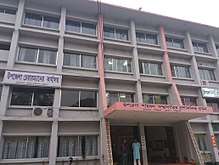
Municipality
- Raozan
Unions
- Raozan
- Kadalpur
- Gohira
- Dabua
- Chikdair
- Urkirchar
- Noajispur
- Noapara
- Paschim Guzara
- Pahartali
- Purba Guzara
- Bagoan
- Binajuri
- Haladia
Economy
Agriculture
The demand for pepper in Chittagong is very broad. The size, color, and taste of the pepper is very unique. A lot of pepper is grown throughout the broad range of Rauzane. In addition to chilli, dhania, piaz, almond, sugarcane, watermelon, cucumber, mustard, fellan etc. are produced. Under the supervision of the Raozan Agricultural Research Center, the cultivars of ginger, garlic, piaz, yellow, tejpata, cinnamon, banana, coconut, pineapple, superiree, olive etc. are cultivated in the hills of Haldia and Pahartali areas.
Other industries and business trade
In the face of the river of Halda until 1960, there were plenty of shoots in Maduunhat zia market. The people of Banskhali used to buy a piece of boat from the Gaduna boat and enter the canal through the river Halda. Raozan was famous for bamboo, cane and cottage making cottage industries. Plow yaws for cultivation of hay, etc, were produced in wood hills. Raozan was famous for the cottage industry, especially the plow yawl. Raozan Chowdhury Hat for the sacrifice, there was a well-known market during the distant English and Pakistan period.
Sights
- Isa Khan Dighi
- Shah Bibi Mosque
- Moisah Bibi Mosque
- Roymukut Dighi
- Laskar Wazir Dighi
- Masterada SuryaSen's Homestead and Memorials
- Jagatpur Ashram
- Habakubi Nabinchandra Sen's Homestead and Memorial Museum
- Mahamuni Buddhism
- Dabua Dhar's house
- Jagannath Devalia and Toran (Dabua)
- Kailashasvara Shiva Temple and Shiva murtis (Dabua, nineteenth century)
- Stirred Buddhist Vihara (Ladakhchari)
- Aburkhil Buddhist Vihara
- Aryamatreya Buddhist monastery (lying idols)
- Sri Sri ketropal Bigroh Mondhir (Janalihat)
- Sri Sri Ramthakur Ashram, Raozan (Janalihat)
Haat bazaar
There are 24 haats and seven annual fairs in Raozan Upazila.
Notable haats:
- Fakir Haat
- Ramzan Ali Haat
- Sombaijja Haat
- Natuan Baghicha Haat
Rivers
The river Karnaphuli flows on the south side of the Raozan Upazila and the river Halda flows on the west side.
Health centres
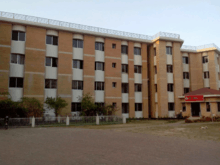
Raozan has two health complexes, and some private hospitals.
Demographics
According to the 1991 Bangladesh census, Raozan had a population of 274,344. Males constituted 50.58% of the population, while females constituted about 49.42% of the population. The average literacy rate is 52.5% (7+ years), above the national average of 32.4%.
According to the 2011 figures, the total population of Raozan Upazila is 3,25,389. Males: 1,63,963 female: 1,61,426 Muslims, 75% of the total population. 18% Hindus, 6% Buddhists and 1% other religions. Indigenous communities like Marma, Tripura, Mogh are living in this Upazila.
Education

The upazila has three universities, three graduate colleges, three higher secondary colleges, four schools and colleges, two kamil madrashas, four fazil madrashas, four alim madrashas, 12 dakhil madrashas, five MPo dakhil madrashas, 48 secondary schools (student), three girls' secondary schools, nine lower secondary schools, 177 government primary schools and community schools and kindergartens.
Universities
Madrasahs
Primary schools
- Raozan Station Model Government Primary School
- Mohammedpur Government Primary School
- East Lelangara Government Primary School
High schools
- chikdir high school
- Agrasara Bouddha Anathalaya High School
- Dalainagar High School
- Fatehnagar Noajishpur Wadudia High School
- Gaschi High School
- Gaurachandra Jatindra High School
- Gohira A. J. Y. M. S. Multilateral Institution
- Guzra Shyama Charan High School
- Haladia High School
- Harpara High School
- Hazrat Yasin Shah Public High School
- Kachu Khain Meah Ali High School
- Kadalpur High School
- Khaiya Khali High School
- Kotowali Ghona Adarsha High School
- Kundeswari Bilika Vidyamandir
- Lelangra Public High School
- Madhyam Adhar Manik High School
- Mahamuni Anglo Pali High School
- Mohammedpur High School
- Nandi Para S.M.Pilot Girls High School
- Noapara High School
- Noapara M.B. Mollick High School
- Noapara Muslim High School
- North Gujra High School
- North Sartha Dargah High School
- Panchkhain Bagoan Sammilani High School
- Paschim Andhar Manik Gujra Rahman High School
- Paschim Binajuri High School
- Purba Gujra High School
- Quepara Girls High School
- Quepara J. C. Sen A & I Institution
- Raozan Aryamitreya Institution
- Raozan R.R.A.C Model High School
- Raozan Salamatullah High School
- Raozan Suresh Vidyayattan
- South Gohira Khan Saheb A Karim High School
- South Noapara High School
- Sultanpur High School
- Unsattor Para High School
- Urkirchar High School
- West Gohira Younus Sufia Chowdhury Public High School
- West Guzra High School
- Yeasin Nagar Model High School
Colleges
- Raozan Government College
- Cuet School & College
- Noapara University College
- Imam Gazzali University College
- Gohira Degree College
- Yeasin Shah College
- Kadalpur School & College
- Mohammedpur School & College
Notable residents
- A. B. M. Fazle Karim Chowdhury, Member of Parliament for constituency Chittagong-6 2001–2006[4] and for Chittagong-5 from 2009 to 2014,[5] and MP for Chittagong-6 again since 2014[6]
- A. B. M. Mohiuddin Chowdhury, mayor of Chittagong (1994–2010), born at Gohira village in 1944[7]
- Abdul Haq Choudhury, writer, born in Raozan in 1922[8]
- Abdullah Al Noman, former Minister of Fisheries
- Anisul Islam Mahmud, Member of Parliament for constituency Chittagong-5 1979–1982[9] and 1986–1990,[10][11] Chittagong-4 2009–2014,[5] and Chittagong-5 again since 2014[12]
- Benimadhab Barua, scholar of ancient Indian languages, Buddhism and law, born at Mahamuni village in 1888[13]
- Ambika Chakrabarty
- Fazlul Qadir Chaudhry, Speaker of the Pakistan National Assembly (1963–1965), born at Gohira village in 1919[14]
- Giasuddin Quader Chowdhury, former Member of Parliament
- Mahbub Ul Alam Choudhury, writer, born at Gohira village in 1927[15]
- Nabinchandra Sen, poet, born at Noapara village in 1847[16]
- Nutan Chandra Singha, businessman, born at Gohira village in 1990[17]
- Saber Hossain Chowdhury, Member of Parliament (MP) for constituency Dhaka-6 1996–2001, and MP for Dhaka-9 since 2009
- Salahuddin Quader Chowdhury, executed war criminal and Member of Parliament, born at Gohira village in 1949[18]
- Shabana, film actress
- Sukumar Barua, poet
- Surya Sen, anti-British revolutionary, born at Noapara village in 1894[19]
- Syed Wahidul Alam, Member of Parliament for constituency Chittagong-5 1991–2006[20]
- Ziauddin Ahmed Bablu, Jatiya Party Member of Parliament
- Daulat Qazi, poet
See also
- Upazilas of Bangladesh
- Districts of Bangladesh
- Divisions of Bangladesh
References
- Partho Protim Dhar (2012), "Raozan Upazila", in Sirajul Islam and Ahmed A. Jamal (ed.), Banglapedia: National Encyclopedia of Bangladesh (Second ed.), Asiatic Society of BangladeshCS1 maint: uses authors parameter (link)
- http://raozandimadrasah.edu.bd
- http://104912.ebmeb.gov.bd
- "Parliament Election Result of 1991,1996,2001 Bangladesh Election Information and Statistics". Vote Monitor Networks. Archived from the original on 29 December 2008. Retrieved 4 February 2018.
- "List of 9th Parliament Members". Bangladesh Parliament.
- "Constituency 283_10th_En". Bangladesh Parliament. Retrieved 17 August 2017.
- "In tears, Ctg bids farewell to Mohiuddin". The Daily Star. 16 December 2017.
- Miah, Md. Majiruddin (2012). "Choudhury, Abdul Haq". In Islam, Sirajul; Jamal, Ahmed A. (eds.). Banglapedia: National Encyclopedia of Bangladesh (Second ed.). Asiatic Society of Bangladesh.
- "List of 2nd Parliament Members". Bangladesh Parliament.
- "List of 3rd Parliament Members". Bangladesh Parliament.
- "List of 4th Parliament Members". Bangladesh Parliament.
- "Constituency 282_10th_En". Bangladesh Parliament.
- Sunithananda, Bhikkhu (2012). "Barua, Benimadhab". In Islam, Sirajul; Jamal, Ahmed A. (eds.). Banglapedia: National Encyclopedia of Bangladesh (Second ed.). Asiatic Society of Bangladesh.
- Khan, Muazzam Hussain (2012). "Chaudhury, Fazlul Quader". In Islam, Sirajul; Jamal, Ahmed A. (eds.). Banglapedia: National Encyclopedia of Bangladesh (Second ed.). Asiatic Society of Bangladesh.
- Akhter, Nasrin (2012). "Chowdhury, Mahbub ul Alam". In Islam, Sirajul; Jamal, Ahmed A. (eds.). Banglapedia: National Encyclopedia of Bangladesh (Second ed.). Asiatic Society of Bangladesh.
- Guha, Bimal (2012). "Sen, Nabinchandra". In Islam, Sirajul; Jamal, Ahmed A. (eds.). Banglapedia: National Encyclopedia of Bangladesh (Second ed.). Asiatic Society of Bangladesh.
- Kamal, Mohammad Mostafa (2012). "Singha, Nutan Chandra". In Islam, Sirajul; Jamal, Ahmed A. (eds.). Banglapedia: National Encyclopedia of Bangladesh (Second ed.). Asiatic Society of Bangladesh.
- Das, Biswadip; Nasiruddin, Gazi (1 October 2013). "War-time terror Salauddin Quader Chy to die". bdnews24.com.
- Shah, Mohammad (2012). "Surya Sen, Mastarda". In Islam, Sirajul; Jamal, Ahmed A. (eds.). Banglapedia: National Encyclopedia of Bangladesh (Second ed.). Asiatic Society of Bangladesh.
- "Parliament Election Result of 1991,1996,2001 Bangladesh Election Information and Statistics". Vote Monitor Networks. Archived from the original on 29 December 2008. Retrieved 4 February 2018.
